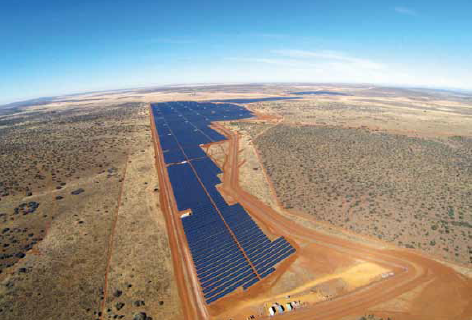|

The 96-MW Jasper solar park in South Africa
Primary school teacher Betha Mberi has seen the light - quite literally. Mberi is a beneficiary of the Jasper Solar Energy Project near the town of Kimberly in the Northern Cape Province of South Africa. The 96-MW solar park came online in November last year and is one of the largest of its kind in Africa.
"Two candles cost $1 [and] I used to struggle to mark books for pupils before the advent of solar power," said Mberi.
The struggle was due to power blackouts - known locally as load-shedding - imposed by public utility Eskom. They have plagued the country during 2015, forcing locals like Mberi to spend more on candles and paraffin and hampering their activities.
In the first six months of 2015, blackouts occurred on 82 of 181 days, according to the Council for Scientific and Industrial Research's report in September.
Apart from frustrating residents, the blackouts have badly dented the country's economic output.
Eskom spokesperson Khulu Phasiwe told AFP in February, "This situation is going to have long-term effects on growth. It's worrying," adding that the situation is expected to remain tight for the next two to three years, until Eskom's new power stations are fully operational.
This was echoed by South African Chamber of Commerce and Industry President Vusi Khumalo. "The load-shedding will no doubt have a negative impact on business, business confidence and consumers alike," Khumalo told ChinAfrica.
Economic slump
South Africa's economic growth is expected to slump as it faces its worst power outages in seven years, exacerbated by the huge demand for power. As the world's top platinum producer, and a major exporter of coal and gold, the rolling power blackouts are having a negative effect on Africa's most industrialized economy.
The South African Reserve Bank (SARB), the country's central bank, revised its 2015 growth forecast down, from 2.5 percent to 2. 2 percent, due to the blackouts. SARB figures show that after a quarter-to-quarter decline of 4 percent in April-June, manufacturing production contracted at a rate of 3.4 percent in the following three months.
According to a World Bank forecast, Eskom's blackouts will stall GDP growth to 2 percent this year. The bank also noted that South Africa's economy increased 1.5 percent last year, the slowest pace since the 2009 recession.
Green advantage
Clean solar power in South Africa, a country that averages more than 2,500 hours of sunshine annually, is a logical alternative to coal and a definitive green option to counter blackout woes.
Solar power generation works similar to any coal, oil, natural gas or nuclear power plant - except the fuel is the sun which means zero emissions, zero hazardous waste and low water use. This technology is able to compete head to head with fossil fuels, which is seen as a game changer. Solar plants are cost-effective and can be built relatively quickly.
South Africa has a target of generating 3,725 MW from renewable energy sources. In 2011, the Department of Energy launched a Renewable Energy Independent Power Producer Procurement Program to contribute to that target and nurture the renewable energy industry. As a direct result of the program, the cost of renewable energy is continuously declining. Presently, it is close to parity with the cost of newly-built traditional energy generation.
The $260-million Jasper solar park, Betha Mberi's savior, produces about 180,000 MW-hours of clean energy annually, enough to power up to 80,000 homes, through a 20-year power purchase agreement with Eskom. Jasper uses more than 325,000 individual solar panels with China's Yingli Solar supplying the photovoltaic modules for the panels.
Jasper was developed by a consortium including SolarReserve, a U.S. developer of utility-scale solar power projects; the Kensani Group, an investment player in South Africa; and Intikon Energy, a South African developer of renewable energy projects.
SolarReserve has other solar projects in South Africa as well. Its 75-MW Lesedi solar project came online in May 2014, and its 100-MW Redstone concentrated solar power (CSP) project, once it is implemented, will supply power to more than 200,000 homes in times of high demand and after sunset. Redstone is promising the lowest cost and will be able to store and supply power even when the sun isn't shining.
Both Redstone and Kathu Solar Park, another 100-MW project, are part of the procurement program. They join two other major solar installations, the 75-MW Kalkbult Solar Park and the 75-MW Letsatsi Solar Park, both of which went live in the past two years.
Other project developers operating in South Africa's solar space now include Riyadh-based water and power developer Acwa Power whose 50-MW Bokpoort CSP is targeted for a 2016 completion and Spanish multinational Abengoa S.A's three plants, Kaxu Solar One, Khi Solar One and Xina Solar One, with a total of 250 MW going all live between 2015 and 2017.
With South Africa's excellent solar resource, solar energy can be a strong part of the country's energy diversification plan that will help meet the growing energy needs as well as reduce reliance on finite sources of power generation that produce carbon emissions, Mary Grikas, Vice President of Communications of SolarReserve, told ChinAfrica.
South Africa is slowly establishing some of the world's largest solar power plants, which will hopefully contribute to the power grid in a significant way and see people like Betha Mberi light candles only on birthday cakes.
(Reporting from South Africa)
|